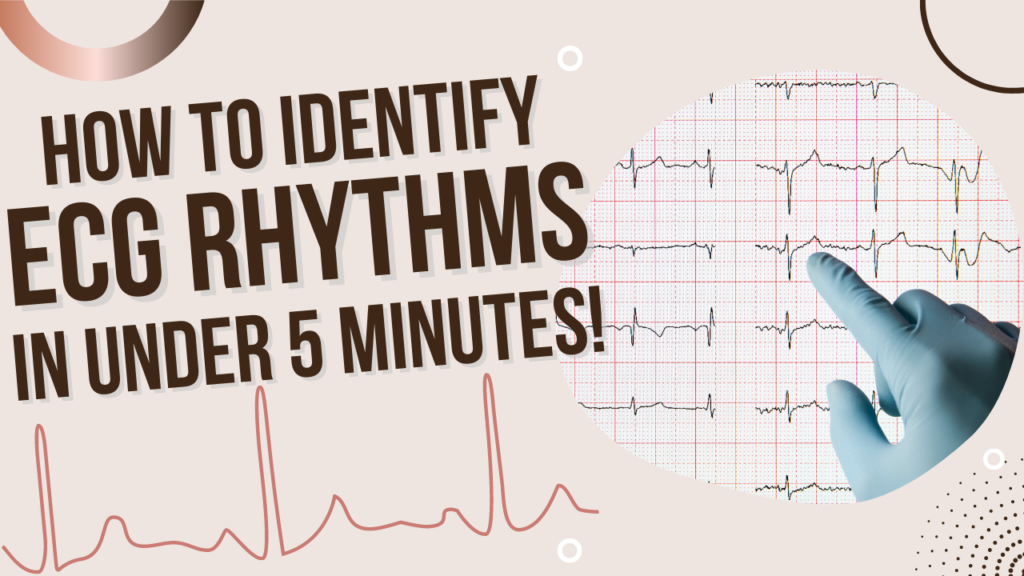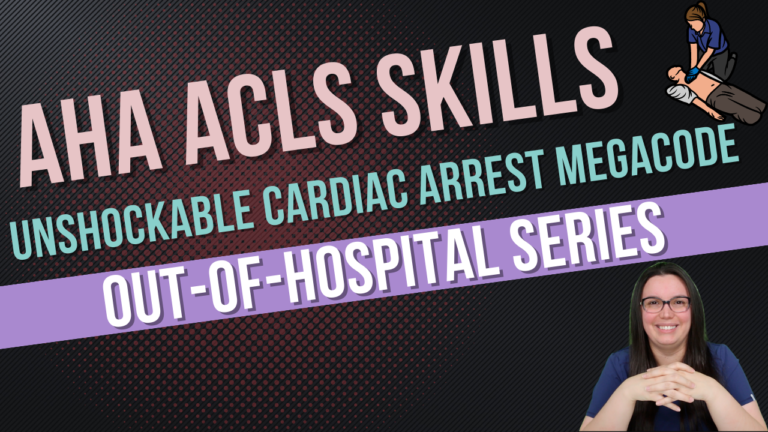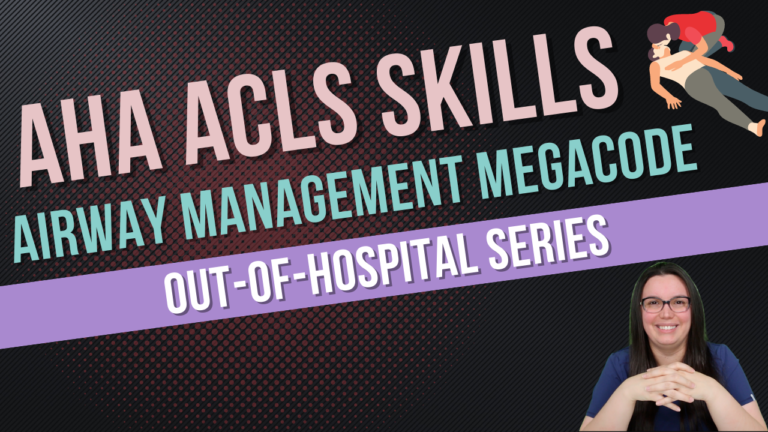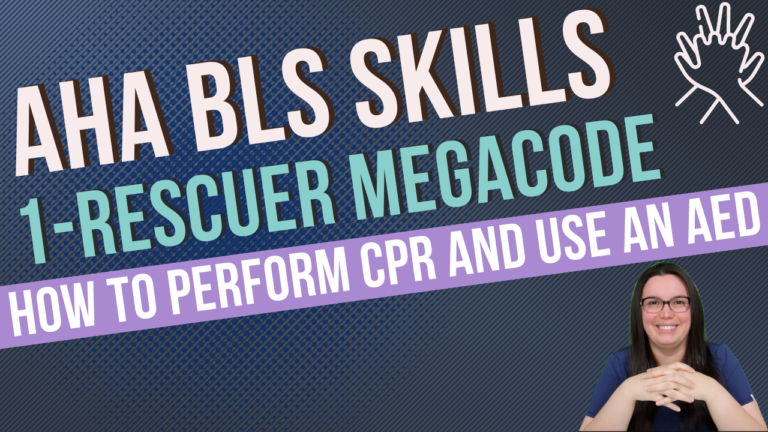Do you know what an ECG rhythm is? If not, don’t worry! You are not alone.
Many people do not know the answer to this question.
An ECG rhythm is simply the pattern of electrical activity that occurs in the heart.
In this blog post, we will teach you how to identify different ECG rhythms in under five minutes!
What is an electrocardiogram rhythm and what does it mean?
An electrocardiogram (ECG) is a test that measures the electrical activity of the heart.
The test is non-invasive, meaning that it does not require surgery or needles.
An ECG can be used to diagnose heart conditions, such as arrhythmias.
Electricity through the Heart
The heart is a muscle that pumps blood through the body.
The heart has its own electrical system that controls the rhythm of the heartbeat.
This electrical system is made up of the sinoatrial (SA) node, the atrioventricular (AV) node, the Bundle of His, and the Purkinje system.
The SA node is located in the right atrium of the heart.
- The SA node is the main pacemaker of the heart, meaning that it sets the pace of the heartbeat.
- The heart rate with the SA node being the primary pacemaker is between 60 to 100 beats per minute.
The AV node is located in the Koch triangle near the coronary sinus on the interatrial septum.
- The AV node delays the electrical signal from the atria to the ventricles. This delay allows the atria to contract and fill the ventricles with blood before the ventricles contract.
- The AV node will take over as the primary pacemaker if the SA node fails to fire.
- The heart rate for the AV node being the primary pacemaker is between 40 to 60 beats per minute.
The Bundle of His is a bundle of fibers that connect the AV node to the Purkinje system.
The Purkinje system is made up of a network of fibers that conduct electrical signals from the AV node to the ventricles.
- The Purkinje system is the final pathway for electrical signals before they reach the ventricles.
- The Purkinje system will take over as the primary pacemaker if the SA and AV nodes fail to fire.
- The heart rate for the Purkinje system being the primary pacemaker is 20 to 40 beats per minute.
Now that you know a little bit about the electrical system of the heart, let’s learn how to identify different ECG rhythms!
Depolarization versus Repolarization
There are two principles of contraction and relaxation in the cardiovascular system: depolarization and repolarization.
Depolarization is the process of the electrical signal moving from the SA node through the AV node and into the ventricles causing contraction.
This causes the ventricles to pump blood out of the heart and into the lungs and body.
Repolarization is the process of allowing the muscle cells in the ventricles to regain their ability to depolarize again (relax).
This allows the ventricles to fill with blood from the atria and lungs.
Normal Electrocardiogram Waveforms
There are three main waveforms that make up a normal ECG: P waves, QRS complexes, and T waves.
P waves are small waves that represent the electrical activity of the atria.
- The P wave occurs during atrial depolarization.
- The atrial electrical impulse is conducted in ring-like waves from the SA node.
- The waveform is visualized as a slower, rounded deflection when compared to the ventricles.
QRS complexes are larger waves that represent the electrical activity of the ventricles during contraction.
- The QRS complex occurs during ventricular depolarization.
- As the conduction reaches the larger ventricular conduction pathway, the bundle branches and Purkinje fibers produce a greater and more rapid depolarization compared to the atria. This depolarization causes a large spike in an ECG.
T waves are smaller waves that represent the electrical activity of the ventricles during relaxation.
- The T wave occurs during ventricular repolarization.
- At the same time, the ventricles are depolarizing, the atria are repolarizing. This repolarization causes a waveform visualized rounded deflection we see.
Electrocardiogram Graph Paper Measuring
Now that we know what the different waveforms represent, let’s learn how to measure them!
Each small square on an ECG graph paper represents 0.04 seconds.
Each large square (made up of 5 squares across and 5 squares up) on an ECG graph paper represents 0.20 seconds.
The height of each small square represents 0.01 mV.
The height of each large square (made up of five squares) represents 0.05 mV.
Calculating Heart Rate on a 6-Second Strip
To easiest method to calculate the heart rate, you will need to count the number of QRS complexes in six seconds and multiply by ten.
To do this, find a six-second section of the ECG that has clear QRS complexes and count the number of complexes.
Once you have counted the number of complexes, multiply by ten to get the heart rate in beats per minute.
For example, if there are twelve QRS complexes in six seconds, the heart rate would be 120 beats per minute.
Calculating the PR Interval
The PR interval is the time it takes for an electrical impulse to travel from the SA node through the AV node.
A normal PR interval is 0.12 to 0.20 seconds or three to five small squares on an ECG graph paper.
To calculate the PRI interval, you will need to find the distance between a P wave and the first QRS complex after that P wave.
Once you have found those two waveforms, count the number of small squares between them.
Each small square on an ECG graph paper represents 0.04 seconds, so you will need to multiply the number of squares by 0.04 to get the PR interval in seconds.
For example, if there are five small squares between the P wave and QRS complex, the PR interval would be 0.20 seconds.
Calculating the QRS Interval
The QRS interval is the time it takes for an electrical impulse to travel through the ventricles.
A normal QRS interval is 0.08 to 0.10 seconds or one to three small squares on an ECG graph paper.
To calculate the QRS interval, you will need to find the distance between the beginning of the QRS complex and the end of that same QRS complex.
Once you have found the waveform, count the number of small squares between them.
Each small square on an ECG graph paper represents 0.04 seconds, so you will need to multiply the number of squares by 0.04 to get the QRS interval in seconds.
For example, if there are two small squares between the beginning and end of the QRS complex, the QRS interval would be 0.08 seconds.
Calculating the QT Interval
The QT interval is the time it takes for an electrical impulse to travel through the ventricles and then be repolarized.
A normal QT interval is 0.36 to 0.44 seconds or nine to eleven small squares on an ECG graph paper.
To calculate the QT interval, you will need to find the distance between the beginning of the QRS complex and the end of the T wave.
Once you have found those two waveforms, count the number of small squares between them.
Each small square on an ECG graph paper represents 0.04 seconds, so you will need to multiply the number of squares by 0.04 to get the QT interval in seconds.
For example, if there are ten small squares between the QRS complex and the end of the T wave, the QT interval would be 0.40 seconds.
Importance of the ST Segment
The ST segment is the flat line between the QRS complex and the T wave.
A normal ST segment should be level with the isoelectric line, which is the flat line on an ECG graph paper.
The ST segment can be used to identify ischemia, which is a decrease in blood flow to the heart.
An ST segment that is elevated above the isoelectric line may be a sign of myocardial infarction or a heart attack.
An ST segment that is depressed below the isoelectric line may be a sign of myocardial ischemia.
The 7 Most Common Types of ECG Rhythms
There are seven types of ECG rhythms that you should be able to identify:
- Normal sinus rhythm
- Sinus bradycardia
- Sinus tachycardia
- Supraventricular tachycardia
- Ventricular Tachycardia
- Ventricular fibrillation
- Asystole
Normal Sinus Rhythm
Normal sinus rhythm is the most common type of ECG rhythm.
It is characterized by a normal P wave, a normal QRS complex, and a normal T wave. Each P wave and QRS wave should be equal distance apart from their corresponding P waves and QRS waves.
The P wave should be upright in leads II, III, and aVF.
The QRS complex should be less than 0.12 seconds or three small squares on an ECG graph paper.
The PR interval should be 0.12 to 0.20 seconds or three to five small squares on an ECG graph paper.
The QT interval should be less than 0.44 seconds or eleven small squares on an ECG graph paper.
Sinus Bradycardia
Sinus bradycardia is characterized by a slow heart rate.
The heart rate should be less than 60 beats per minute. Each P wave and QRS wave should be equal distance apart from their corresponding P waves and QRS waves.
The P wave should be upright in leads II, III, and aVF.
The QRS complex should be less than 0.12 seconds or three small squares on an ECG graph paper.
The PR interval should be 0.12 to 0.20 seconds or three to five small squares on an ECG graph paper.
The QT interval should be less than 0.44 seconds or eleven small squares on an ECG graph paper.
Sinus Tachycardia
Sinus tachycardia is characterized by a fast heart rate.
The heart rate should be greater than 100 beats per minute but less than 150 beats per minute. Each P wave and QRS wave should be equal distance apart from their corresponding P waves and QRS waves.
The P wave should be upright in leads II, III, and aVF.
The QRS complex should be less than 0.12 seconds or three small squares on an ECG graph paper.
The PR interval should be 0.12 to 0.20 seconds or three to five small squares on an ECG graph paper but may be smaller due to the faster heart rate.
The QT interval should be less than 0.44 seconds or eleven small squares on an ECG graph paper.
Supraventricular Tachycardia
Supraventricular tachycardia is characterized by a fast heart rate originating in the atria.
The heart rate should be greater than 150 beats per minute. The P waves may be absent, inverted, or have a different shape than normal.
Each QRS wave should be an equal distance apart from its corresponding QRS waves.
The QRS complex should be less than 0.12 seconds or three small squares on an ECG graph paper.
The PR interval may not be present due to the fast heart rate.
The QT interval may not be present due to the fast heart rate.
Ventricular Tachycardia
Ventricular tachycardia is characterized by a fast heart rate originating in the ventricles.
The heart rate should be greater than 150 beats per minute. The P waves may be absent, inverted, or have a different shape than normal.
Each QRS wave should be an equal distance apart from its corresponding QRS waves.
The QRS complex should be wide and greater than 0.12 seconds or three small squares on an ECG graph paper.
The PR interval will not be present due to the fast heart rate.
The QT interval will not be present due to the fast heart rate.
This can be a life-threatening condition and requires immediate medical attention.
Ventricular Fibrillation
Ventricular fibrillation is characterized by an irregular heart rhythm originating in the ventricles.
The P waves will be absent and the QRS waves will be irregular.
You will not be able to identify any regularity in the QRS waves due to the erratic fibrillation occurring in the ventricles.
This is a life-threatening condition and requires immediate medical attention.
Asystole
Asystole is characterized by a complete absence of electrical activity in the heart.
The P waves and QRS waves will be absent.
There will be a flat line on the ECG tracing.
This is a life-threatening condition and requires immediate medical attention.














